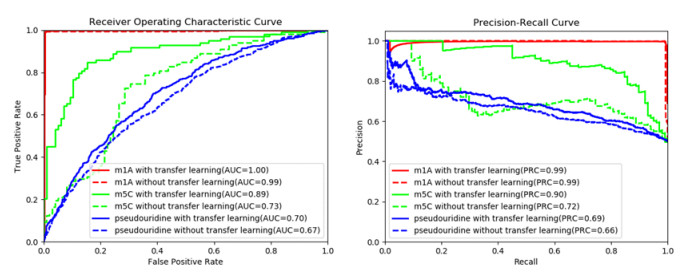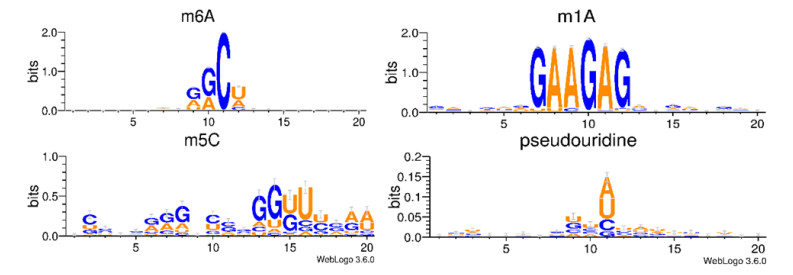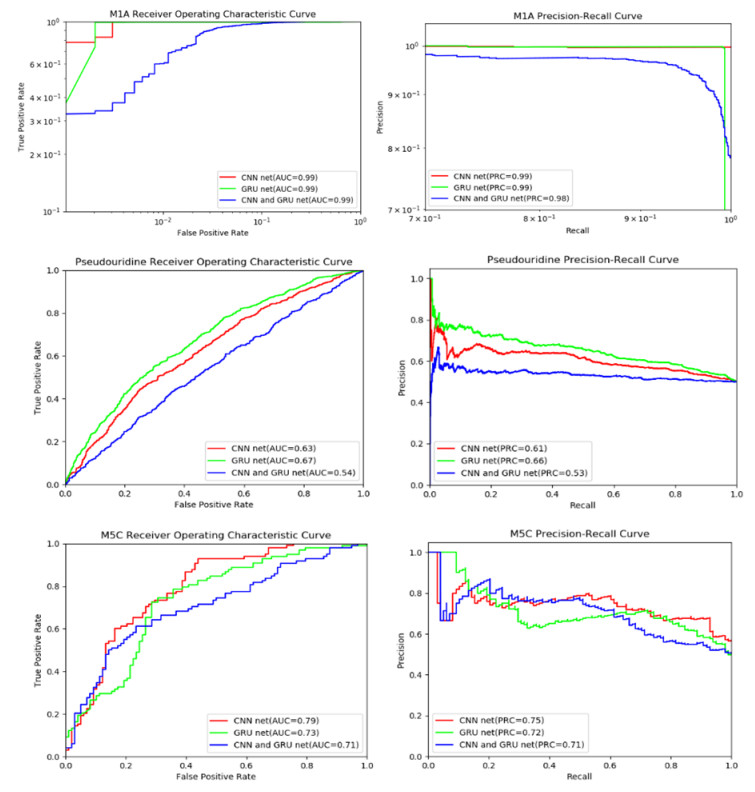|
[1]
|
S. Dunin-Horkawicz, A. Czerwoniec, M. J. Gajda, et al., MODOMICS: A database of RNA modification pathways, Nucleic Acids Res., 34(2006), D145–D149.
|
|
[2]
|
J. H. Ge and Y. T. Yu, RNA pseudouridylation: New insights into an old modification, Trends Biochem. Sci., 38(2013), 210–218. 2. J. H. Ge and Y. T. Yu, RNA pseudouridylation: New insights into an old modification, Trends Biochem. Sci., 38(2013), 210–218.
|
|
[3]
|
M. Charette and M. W. Gray, Pseudouridine in RNA: what, where, how, and why, IUBMB Life, 49(2010), 341–351. 3. M. Charette and M. W. Gray, Pseudouridine in RNA: what, where, how, and why, IUBMB Life, 49(2010), 341–351.
|
|
[4]
|
D. R. Davis, C. A. Veltri, L. J. J. o. B. S. Nielsen, et al., An RNA model system for investigation of pseudouridine stabilization of the codon-anticodon interaction in tRNALys, tRNAHis and tRNATyr, J. Biomol. Struct. Dyn., 15(1998), 1121–1132.
|
|
[5]
|
A. Basak and C. Query, A pseudouridine residue in the spliceosome core is part of the filamentous growth program in yeast, Cell Reports, 8(2014), 966–973.
|
|
[6]
|
X. Yang, Y. Yang, B. F. Sun, et al., 5-methylcytosine promotes mRNA export-NSUN2 as the methyltransferase and ALYREF as an m5C reader, Cell Res., 27(2017), 606–625.
|
|
[7]
|
M. Frye and F. M. Watt, The RNA methyltransferase Misu (NSun2) mediates Myc-induced proliferation and is upregulated in tumors, Curr. Biol., 16(2006), 971–981.
|
|
[8]
|
X. Wang, Z. Lu, A. Gomez, et al., N6-methyladenosine-dependent regulation of messenger RNA stability, Nature, 505(2014), 117–120.
|
|
[9]
|
C. Roost, S. R. Lynch, P. J. Batista, et al., Structure and thermodynamics of N6-methyladenosine in RNA: A spring-loaded base modification, J. Am. Chem. Soc., 137(2015), 2107–2115.
|
|
[10]
|
T. Chen, Y. J. Hao, Y. Zhang, et al., m6A RNA methylation is regulated by micrornas and promotes reprogramming to pluripotency, Cell Stem Cell, 16(2015), 289–301.
|
|
[11]
|
S. Geula, S. Moshitch-Moshkovitz, D. Dominissini, et al., m6A mRNA methylation facilitates resolution of naive pluripotency toward differentiation, Science, 347(2015), 1002–1006.
|
|
[12]
|
X. Li, X. Xiong, K. Wang, et al., Transcriptome-wide mapping reveals reversible and dynamic N1-methyladenosine methylome, Nat. Chem. Biol., 12(2016), 311.
|
|
[13]
|
S. Nachtergaele and C. J. R. B. He, The emerging biology of RNA post-transcriptional modifications, RNA Biol., 14(2016), 156–163.
|
|
[14]
|
W. Chen, P. M. Feng, H. Tang, et al., RAMPred: Identifying the N-1-methyladenosine sites in eukaryotic transcriptomes, Sci. Rep., 6(2016), 31080.
|
|
[15]
|
W. Chen, H. Tang, J. Ye, et al., iRNA-PseU: Identifying RNA pseudouridine sites, Mol. Ther.-Nucl. Acids, 5(2016).
|
|
[16]
|
J. J. He, T. Fang, Z. Z. Zhang, et al., PseUI: Pseudouridine sites identification based on RNA sequence information, BMC Bioinform., 19(2018), 306.
|
|
[17]
|
W. R. Qiu, S. Y. Jiang, Z. C. Xu, et al., iRNAm5C-PseDNC: Identifying RNA 5-methylcytosine sites by incorporating physical-chemical properties into pseudo dinucleotide composition, Oncotarget, 8(2017), 41178–41188.
|
|
[18]
|
J. W. Li, Y. Huang, X. Y. Yang, et al., RNAm5Cfinder: A web-server for predicting RNA 5-methylcytosine (m5C) sites based on random forest, Sci. Rep., 8(2018).
|
|
[19]
|
P. M. Feng, H. Ding, H. Yang, et al., iRNA-PseColl: Identifying the occurrence sites of different RNA modifications by incorporating collective effects of nucleotides into PseKNC, Mol. Ther.-Nucl. Acids, 7(2017), 155–163.
|
|
[20]
|
W. Chen, P. M. Feng, H. Yang, et al., iRNA-3typeA: Identifying three types of modification at RNA's adenosine sites, Mol. Ther.-Nucl. Acids, 11(2018), 468–474.
|
|
[21]
|
Y. Huang, N. N. He, Y. Chen, et al., BERMP: A cross-species classifier for predicting m6A sites by integrating a deep learning algorithm and a random forest approach, Int. J. Biol. Sci., 14(2018), 1669–1677.
|
|
[22]
|
J. J. Xuan, W. J. Sun, P. H. Lin, et al., RMBase v2.0: Deciphering the map of RNA modifications from epitranscriptome sequencing data, Nucleic Acids Res., 46(2018), D327–D334.
|
|
[23]
|
D. Dominissini, S. Moshitch-Moshkovitz, S. Schwartz, et al., Topology of the human and mouse m6A RNA methylomes revealed by m6A-seq, Nature, 485(2012), U201–U284.
|
|
[24]
|
L. Fu, B. Niu, Z. Zhu, et al., CD-HIT: Accelerated for clustering the next-generation sequencing data, Bioinformatics, 28(2012), 3150–3152.
|
|
[25]
|
W. Z. Li and A. Godzik, Cd-hit: A fast program for clustering and comparing large sets of protein or nucleotide sequences, Bioinformatics, 22(2006), 1658–1659.
|
|
[26]
|
L. Zhu, H. B. Zhang and D. S. J. B. Huang, Direct AUC optimization of regulatory motifs, Bioinformatics, 33(2017), i243.
|
|
[27]
|
H. Zhang, L. Zhu and D. S. J. S. R. Huang, WSMD: Weakly-supervised motif discovery in transcription factor ChIP-seq data, Sci. Rep., 7(2017).
|
|
[28]
|
G. H. Chuai, H. H. Ma, J. F. Yan, et al., DeepCRISPR: Optimized CRISPR guide RNA design by deep learning, Genome Biol., 19(2018).
|
|
[29]
|
Q. Zhang, L. Zhu and D. S. Huang, High-order convolutional neural network architecture for predicting DNA-protein binding sites, IEEE/ACM Transact. Comput. Biol. Bioinform., (2018), 1.
|
|
[30]
|
Q. Zhang, L. Zhu, W. Bao, et al., Weakly-supervised convolutional neural network architecture for predicting protein-DNA binding, IEEE/ACM Transact. Comput. Biol. Bioinform., (2018), 1.
|
|
[31]
|
A. Krizhevsky, I. Sutskever and G. E. Hinton, ImageNet classification with deep convolutional neural networks, NIPS. Curran Assoc. Inc., (2012).
|
|
[32]
|
D. P. Kingma and J. J. C. S. Ba, Adam: A method for stochastic optimization, (2014).
|
|
[33]
|
C. Tan, F. Sun, K. Tao, et al., A survey on deep transfer learning, (2018).
|
|
[34]
|
G. Litjens, T. Kooi, B. E. Bejnordi, et al., A survey on deep learning in medical image analysis, Med. Image Anal., 42(2017), 60–88.
|
|
[35]
|
S. Liang, R. G. Zhang, D. Y. Liang, et al., Multimodal 3D denseNet for IDH genotype prediction in gliomas, Genes, 9(2018).
|
|
[36]
|
L. Zhu, W. L. Guo, C. Lu, et al., Collaborative completion of transcription factor binding profiles via local sensitive unified embedding, IEEE Transact. NanoBiosci., (2016), 1.
|
|
[37]
|
J. X. Wang, L. Chen, Y. Wang, et al., A computational systems biology study for understanding salt tolerance mechanism in rice, Plos One, 8(2013), 177–194.
|
















 DownLoad:
DownLoad: